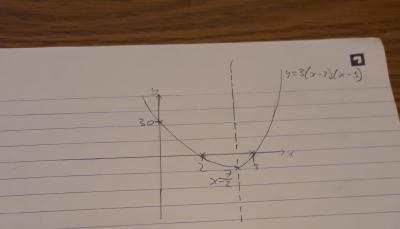How do you graph, label the vertex, axis of symmetry and x intercepts of #y=3(x-2)(x-5)#?
1 Answer
Find points, then follow steps to sketch your graph
Explanation:
To graph this curve, we need to find some points on it.
We'll start by finding the x-intercepts.
Let
So passes through
This first step is akin to solving a quadratic. I'm doing this first since the curve is given to us with the factors, so we don't need to factorize. If we instead were given the curve in the form
Now we're going to find the y-intercept.
Let
So passes through
This information is enough for us to sketch the graph. However, since the question asks us to find the axis of symmetry - essentially the x-coordinate of the turning point - we might as well do this before sketching.
If f(x) is a quadratic, the axis of symmetry will always be halfway between the two roots of
So
Now for the good bit - drawing the graph
- Start off by drawing your axes. Put arrow heads on them, and mark them as 'x' and 'y'.
- Then mark on your x-intercepts. Make them look relatively to scale, but you need not be exact.
- Now draw the curve. You will probably have to rub out your graph quite a few times to get it right.
- Pay attention to the ends of the graph, which should always be getting steeper but not straight, and to the turning point, which should be smooth and not point.
- Add your y-intercept where the curve crosses the axis.
- Label the curve with the equation
- If required, draw the line of symmetry on the graph and label it
Here's one I prepared earlier!

And this is the actual graph
graph{3(x-2)(x-5) [-14.89, 17.14, -7.69, 8.33]}
